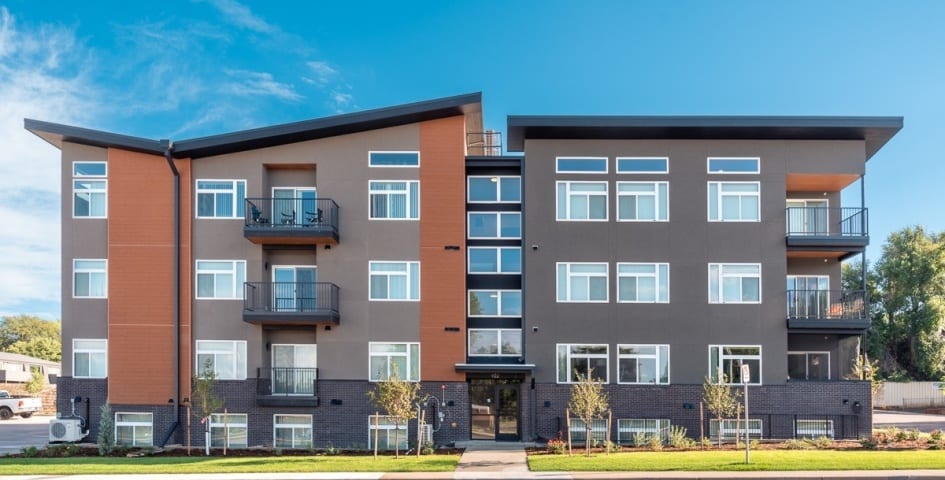All photos courtesy of Structural Insulated Panel Association.
Building operations are responsible for 30 percent of global final energy consumption and 26 percent of global energy-related emissions, according to the latest findings from the International Energy Agency (IEA).¹ These concerning statistics are coupled with the IEA’s prediction that by 2030, global floor area is expected to increase by an estimated 15 percent, which is equivalent to the entire built floor area of North America.² More floor area to heat and cool equals more energy consumed.
These numbers remind us that “energy efficiency” and “sustainability” are not just buzzwords thrown around during industry discussions—they are real areas of concern with many different stakeholders, including building owners, facility managers and building users. After all, pressing issues such as climate change and rising energy costs are high priorities for many.
This puts responsibility on the shoulders of architects and designers to deliver high-performance, energy-efficient structures that can contribute to global sustainability targets. To meet this moment, project teams are carefully examining the building envelope, paying close attention to the selection of advanced materials and construction methods. As the physical and thermal barrier between the external environment and interior conditioned spaces, the building envelope has a very close relationship with a structure’s energy transfer and consumption. Consequently, the building envelope plays a critical role when it comes to designing an energy-efficient structure.
One proven way that design teams can deliver a virtually airtight, low-embodied building envelope is by integrating structural insulated panels (SIPs) during the planning stages of a project.

Leveraging SIPs in Roof, Walls and Floors to Bolster Energy Performance
A forward-thinking approach to building envelope construction, SIPs can be used in the roof, walls and floors of residential, multifamily and light commercial projects. The engineered panels are made by sandwiching the core of rigid foam insulation between two structural facings. Manufactured under factory-controlled conditions, customizable SIPs can be manufactured in large sizes (up to 8 feet x 24 feet) and in a range of thicknesses (from 4 ½ inches - 12 ½ inches) to meet exact project specifications and thermal performance requirements. The result is a nearly air impermeable building system that experiences minimal air leakage. In turn, architects and designers can optimize energy consumption to deliver an energy-efficient, low carbon and airtight structure.
Unlike conventional building systems, the panels’ R-value extends beyond laboratory testing and is realized in real-world scenarios. R-value is determined through standard testing in a controlled environment with no air movement. But in application, the panels are continuously exposed to external elements that impact thermal performance. Additionally, any metal components incorporated in structures built using traditional construction methods facilitate thermal bridging, potentially reducing a system’s thermal performance by up to 50 percent. SIPs, which are structurally self-sufficient with insulation and facing in one unit, do not compromise their thermal integrity, alleviating additional continuous insulation needs on the building exterior.
When comparing “framing factors” (a percentage of the total solid exterior wall area), the nearly impermeable nature of SIP construction is even more apparent: SIPs’ framing factor is about five percent, compared to nearly 25 percent in traditional framing. When the Department of Energy's Oak Ridge National Laboratory (ORNL) compared a SIP building with a stick-framed building side-by-side, the laboratory found the SIP structure was 15 times more airtight. Underlining its performance as a complete building system, when tested for the whole-wall R-value, they found SIPs did not compromise their thermal integrity. In contrast, a loose-fill fiberglass attic insulation rated at R-19 performed at R-9.2 when the temperatures dipped.
It's important to note that because SIP construction creates a virtually airtight shell, buildings have to rely on mechanical make-up air. There’s a reason why the building science mantra, “build tight and ventilate right,” is often used in the same sentence as SIP construction. When it comes to heating and cooling a SIP structure, proper HVAC sizing is critical because an oversized system will fail to reach the steady operating rate the equipment was designed for. A “short cycling” system will only run for a very brief period of time because it arrives at the temperature set point so quickly that it doesn’t have time to dehumidify the air properly. A short cycling system is not only a costly and wasteful energy drain, but it may also cause mold and damp conditions, which can pose both immediate and long-term health risks to building occupants. But with a properly sized HVAC unit inside the conditioned SIP envelope, the system can take expended air, dilute it and then redistribute it for a healthier indoor environment.

Key Considerations for Designing with SIPs
To help architects and designers meet growing demand for energy-efficient structures, the Structural Insulated Panel Association (SIPA) offers an in-depth analysis of SIP design principles through an arsenal of resources, including this one: “Designing with SIPS: Design Considerations.”
Some of the key considerations outlined in this free guide include:
- SIPs help project teams meet building code thermal envelope requirements and eliminate additional continuous insulation needs on the building exterior. The SIPA-recommended path to demonstrating SIP compliance with building code thermal envelope requirements is to use the U-factor (thermal transmittance) method.
- SIPs provide a high-performance enclosure that experiences minimal air leakage. To help illustrate this point,the guide highlightsa mainstream low-air-leakage project: the Innovation Center at the Rocky Mountain Institute, a net-zero office building located in Basalt, Colorado. The project team used SIPs to enclose the 15,610 square-foot structure, which achieved a LEED Platinum certification and was named the largest Passive Certified structure in the world at the time of its opening in late 2015. The state-of-the-art office building boasts an air leakage rate of 0.36 ACH50, which is 97 percent less leakage than standard commercial buildings. Impressively, the building is designed to generate two times more energy than it uses. What’s more, the 10.8 percent premium to achieve its net-zero designation was paid back in less than four years with the help of its high-performance SIP construction.
- The structural capabilities of SIPs make it possible to prioritize architectural creativity and aesthetic appeal while optimizing energy consumption. Custom-made to accommodate project specifications and the architect’s design vision, SIPs are strong and can span up to 24 feet when incorporating structural connections (splines), eliminating intermediate support structures and creating spectacular vaulted ceilings. SIP manufacturers publish charts to determine load capacities and will work closely with designers to provide an understanding of how SIP height, thicknesses and connection methods will impact the structure’s design.

